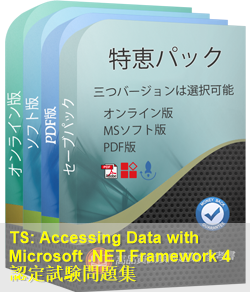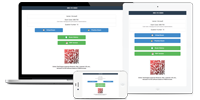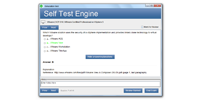さまざまな記憶方法
毎日新しい知識を学んでいるだけでなく、常に忘れられていた知識も私たちは記憶と鍛造の過程にあったと言うことができます。 これには優れたメモリアプローチが必要です、そして070-516研究の脳ダンプはそれを上手く行います。070-516準備ガイドは、テキスト、画像、グラフィックメモリ方式などの多様化を採用し、情報を学ぶためにマークアップを区別する必要があります。 全体的なレイアウト、目標とされた長期記憶の形成へのより良い手がかり、そして実践のサイクルを通して、知識をより深く私の頭の中に印刷させてください。070-516試験問題は非常に科学的かつ妥当であり、あなたは簡単にすべてを覚えることができます。
強力なユーザー共有プラットフォーム
もちろん、個人的な学習効果は特に目立ちません。なぜなら、この問題を解決するために、テストの難点、良いアップデートを同時に得られないという最新の試験の傾向を掴むのは難しいからです。 圧倒的多数のユーザーのための070-516研究問題集は、ユーザーが共有するための強力なプラットフォームを提供します。 ここでは、070-516試験問題のすべてのユーザが自分のID番号を通してプラットフォームと他のユーザにログオンして共有し交換することができ、プラットフォーム上でさらに仲良くなるために多くの人々と努力することができます。 他の、学習や生活の中で彼らの困難を解決するためにお互い。070-516準備ガイドは、学習環境だけでなく、家庭のような学習環境を作成することもできます。
便利なPDFダウンロードモード
ユーザーのオフラインでの読解を容易にするために、070-516学習問題集は、特にユーザー向けのPDFモードを開発するために、破片の時間を学習に使用することができます。 このモードでは、ユーザーはダウンロードして印刷すること、紙にメモを取ることが簡単であること、および自分の記憶の弱いリンクを学ぶために、教材内の070-516準備ガイドを知ることができます。 我々の070-516試験問題とユーザの効率を非常に改善します。 あるいは、いわゆる「いい」を忘れてしまうかもしれませんが、今ではオンラインで読むのに便利なあらゆる種類のデジタル機器ですが、私たちの多くは、彼らの記憶パターンを深めるために書面で使われています。 私たちの070-516準備ガイドは、この点でユーザーの需要を満たすのに非常に良いものです。ユーザーが良い環境で読み書きできるようにすることで、学んだことを継続的に統合することができます。
私たちの070-516研究の問題集は、この点でユーザの要求を満たすのに非常に役立ちます。070-516準備ガイドは高品質です。 それでテストの準備をするためのすべての効果的な中心的な習慣があります。 私たちの職業的能力により、070-516試験問題を編集するのに必要なテストポイントに同意することができます。 それはあなたの難しさを解決するための試験の中心を指しています。 だから高品質の材料はあなたが効果的にあなたの試験に合格し、目標を達成するために簡単に感じるようにすることができます。
Microsoft TS: Accessing Data with Microsoft .NET Framework 4 認定 070-516 試験問題:
1. You use Microsoft Visual Studio 2010 and Microsoft .NET Framework 4.0 to create an application.
The application connects to a Microsoft SQL Server 2008 database.
You need to use a spatial value type as a parameter for your database query. What should you do?
A) Set the parameter's SqlDbType to Structured. Set the parameter's TypeName to GEOMETRY.
B) Set the parameter's SqlDbType to Udt. Set the parameter's UdtTypeName to GEOMETRY.
C) Set the parameter's SqlDbType to Binary.
D) Set the parameter's SqlDbType to Variant.
2. You have a ContosoEntities context object named context and a Color object stored in a variable named color.
You write the following code:
context.Colors.DeleteObject(color); context.SaveChanges();
When the code runs, it generates the following exception:
System.Data.UpdateException: An error occurred while updating the entries. See
the inner exception for detials. --->
System.Data.SqlClient.SqlException: The DELETE satement conflicted with the
REFERENCE constraint "FK_PartColor".
The conflict occurred in database "Contoso", table "dbo.Parts", column
'ColorId'
You need to resolve the exception without negatively impacting the rest of the application. What should you do?
A) In the database, remove the foreign key association between the Parts table and the Colors table, and then update the entity data model.
B) Add a transation around the call to the SaveChanges() method and handle the exception by performing a retry.
C) Change the End1 OnDelete proprety of the FK_PartColor association from None to Cascade
D) Change the End2 OnDelete proprety of the FK_PartColor association from None to Cascade
E) Add code before the call to the DeleteObject() method to examine the collection of Part objects associated with the Color object and then assign null to the Color property for each Part object.
3. You use Microsoft Visual Studio 2010 and Microsoft .NET Framework 4.0 to create a Windows
Communication Foundation (WCF) Data Services service.
You discover that when an application submits a PUT or DELETE request to the Data Services service, it
receives an error.
You need to ensure that the application can access the service. Which header and request type should you
use in the application?
A) an HTTP ContentType header as part of a GET request
B) an X-HTTP-Method header as part of a POST request
C) an X-HTTP-Method header as part of a GET request
D) an HTTP ContentType header as part of a POST request
4. You use Microsoft .NET Framework 4.0 to develop an application that connects to two separate Microsoft
SQL Server 2008 databases.
The Customers database stores all the customer information, and the Orders database stores all the order
information.
The application includes the following code. (Line numbers are included for reference only.)
01 try
02 {
03 conn.Open();
04 tran = conn.BeginTransaction("Order");
05 SqlCommand cmd = new SqlCommand();
06 cmd.Connection = conn;
07 cmd.Transaction = tran;
08 tran.Save("save1");
09 cmd.CommandText = "INSERT INTO [Cust].dbo.Customer " + "(Name,
PhoneNumber) VALUES ('Paul Jones', " + "'404-555-1212')";
10 cmd.ExecuteNonQuery();
11 tran.Save("save2");
12 cmd.CommandText = "INSERT INTO [Orders].dbo.Order " + "(CustomerID)
VALUES (1234)";
13 cmd.ExecuteNonQuery();
14 tran.Save("save3");
15 cmd.CommandText = "INSERT INTO [Orders].dbo." + "OrderDetail (OrderlD,
ProductNumber) VALUES" + "(5678, 'DC-6721')";
16 cmd.ExecuteNonQuery();
17 tran.Commit();
18 }
19 catch (Exception ex)
20 {
21 ...
22 }
You run the program, and a timeout expired error occurs at line 16. You need to ensure that the customer
information is saved in the database.
If an error occurs while the order is being saved, you must roll back all of the order information and save the
customer information.
Which line of code should you insert at line 21?
A) tran.Rollback();
B) tran.Rollback("save2");
C) tran.Rollback("save2"); tran.Commit();
D) tran.Rollback(); tran.Commit();
5. You use Microsoft Visual Studio 2010 and Microsoft .NET Framework 4.0 to create an application.
You are creating the data layer of the application. You write the following code segment.
(Line numbers are included for reference only.)
01 public static SqlDataReader GetDataReader(string sql)
02 {
03 SqlDataReader dr = null;
04 ...
05 return dr;
06 }
You need to ensure that the following requirements are met: The SqlDataReader returned by the GetDataReader method can be used to retreive rows from the database.
--
SQL connections opened within the GetDataReader method will close when the SqlDataReader is closed.
Which code segment should you insert at the line 04?
A) SqlConnection cnn = new SqlConnection(strCnn); SqlCommand cmd = new SqlCommand(sql, cnn); cnn.Open(); { try { dr = cmd.ExecuteReader(); cnn.Close(); } catch {
throw;
}
}
B) using(SqlConnection cnn = new SqlConnection(strCnn)) { try { SqlCommand cmd = new SqlCommand(sql, cnn); cnn.Open(); dr = cmd.ExecuteReader(); } catch {
throw;
}
}
C) SqlConnection cnn = new SqlConnection(strCnn); SqlCommand cmd = new SqlCommand(sql, cnn); cnn.Open(); { try { dr = cmd.ExecuteReader(); } finally {
cnn.Close();
}
}
D) SqlConnection cnn = new SqlConnection(strCnn); SqlCommand cmd = new SqlCommand(sql, cnn);
cnn.Open();
{
try
{
dr = cmd.ExecuteReader(CommandBehavior.CloseConnection);
}
catch
{
cnn.Close();
throw;
}
}
質問と回答:
| 質問 # 1 正解: B | 質問 # 2 正解: E | 質問 # 3 正解: B | 質問 # 4 正解: C | 質問 # 5 正解: D |


 490 お客様のコメント
490 お客様のコメント





